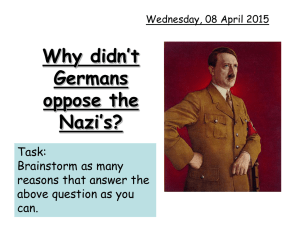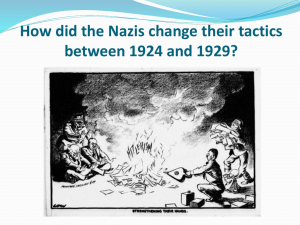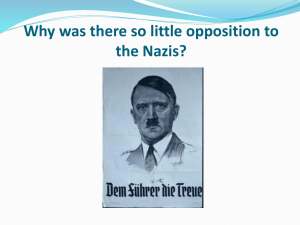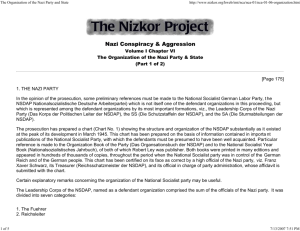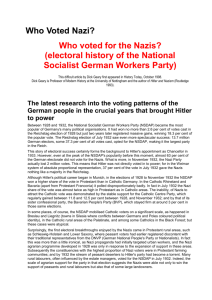Advanced Higher 7 november
advertisement
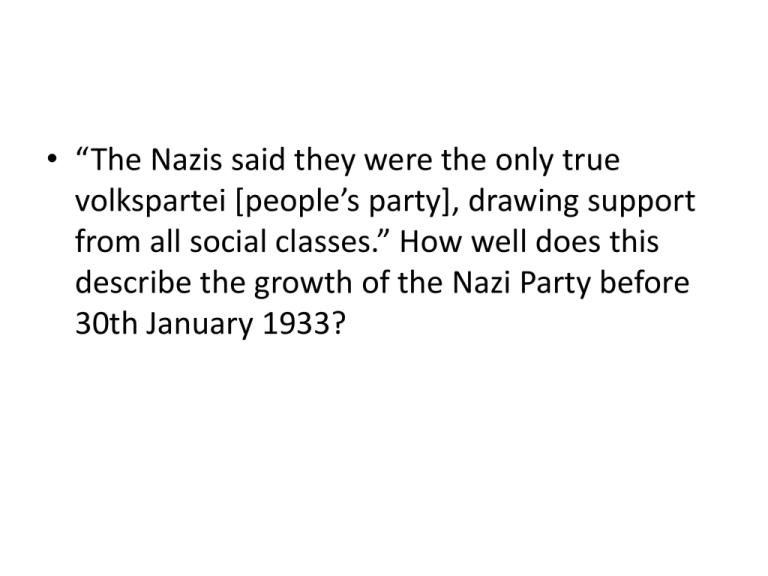
• “The Nazis said they were the only true volkspartei [people’s party], drawing support from all social classes.” How well does this describe the growth of the Nazi Party before 30th January 1933? Getting to grips with the question • The aim of this essay is to enable the candidate to review and discuss the appeal of Nazism across a wide social base, from its foundation in 1919 until the assumption of power. Many essays might focus on the later years of the period, from 1928 when the Nazis began to make inroads into the farming areas of North Germany. Candidates ought to review the intense debate that has long existed on who voted Nazi. Issues to consider • I’d firstly look at various stages of the Nazi era 1. 1919-24 2. 1924-28 3. 1928-33 • The Nazi appeal- Who votes Nazi? (numbers, social class etc) • Membership of the Nazi Party (numbers, social class, jobs etc) A people’s party? • Make sure your findings keep relating to the idea of a people’s party. This gets good analysis marks. This article will help • Who voted Nazi • youtube who voted nazi Refer to the following • Social class – the Mittelstand (petty bourgeoisie) were well represented. Likewise farmers, especially peasant farmers. • • Economic status of members, supporters and voters. Above all (cf their political rivals) NSDAP was a ‘catch-all’ party, but certain groups (eg teachers) were well represented. • • Age – over a third of NSDAP members in 1933 were under age of 30, but the Nazi vote was higher the more older or retired people lived in the electoral district. • • Gender: irony − women excluded from leadership status within Nazi movement but by the Depression years in some constituencies the recorded female vote for NSDAP was higher than the male vote. • • Geography – northern and eastern Germany (in their agricultural constituencies) solid for NSDAP by 1933. • • Denomination – many Protestants voted Nazi. • • ‘Mentalities’ – Nazis key into rejection of Republic and republican values by millions of voters; beneficiaries of the surge towards authoritarianism. • • Role of propaganda. The ‘only’ people’s party? • • SPD – in particular spoke for the skilled working class. Working class loyalties and values were deeply embedded in its million members. • • KPD – attracted many of the unemployed and young. • • Centre – origins in Bismarck’s kulturkampf, attracting solid support from millions of Catholics. • • DDP won votes from many among the better educated and more affluent layers. • • DVP of the bürgertum (the middle and upper classes). • • DNVP – conservative nationalists. Historiography • The traditional Marxist view of Nazism was that it was ‘petty bourgeois’, its core support was the middle class, but especially the lower middle class. Such a view is now superannuated. But the Hungarian Marxist Mihaly Vajda (1976) has provided a thoughtful analysis on Nazism. He argues that the unemployed who supported the NSDAP were ‘new’, “proletarianised out of a petty bourgeois, mostly peasant milieu.” Noting the steady rise in right wing voters, Vajda argues that the years of Nazism’s surge in growth, “As soon as they saw a strong and influential party promising both the improvement of their social position and the ‘rise’ of the German nation, they immediately joined it.” • Many years ago Richard Brady (1937) argued that “there was a plank in the Nazi platform to meet the prejudices of nearly every group to be appealed to.” • More recently, Ian Kershaw (1998) writes “the NSDAP were no mere middle-class party, as used to be thought. Though not in equal proportions, the Hitler Movement could reasonably claim to have won support from all sections of society. No other party throughout the Weimar Republic could claim the same.” • Richard J Evans (2005): cautions against the argument that unemployment drove people to support the Nazis: “The unemployed flocked above all to the Communists.” He emphasises the collapse of “the conventional political right.” Fear drove masses of such people towards Hitler and the Nazis. By 1932 the Nazis were “a catch all party of social protest with particularly strong middle class support and relatively weak working class backing at the polls.” The Nazis successfully projected an image of dynamism and salvation of the national community. • Dick Geary (1993): ably encapsulated research findings to that date. He reminds us that most Germans did not support Nazism. So who did? “Nazi electoral support was much stronger in Protestant than Catholic Germany, a feature of both urban and rural areas.” The Nazis did better in small towns than in the cities. Working class Nazis tended to be from small towns, working in artisan or cottage industry. The manual unemployed supported the KPD rather than the NSDAP. • Historians such as Evans, Geary and Kershaw have relied heavily on the painstaking research of Germanborn historians such as Jürgen Falter and Detlef Mühlberger. The former has described the Nazis as “A People’s Party with a middle class belly.” The latter’s research “points overwhelmingly in one direction: that the Nazi movement effectively transcended the class divide.” Though in unequal proportions, ‘the ability of the Nazis to generate support from all social classes gave the Nazi movement its potency.” • Tim Kirk (2006): “Above all, the Nazi movement was a young movement… The average age of a party member in 1930 was 31.” “By July 1932 the NSDAP represented a greater range of social and economic groups than any of its competitors.”
